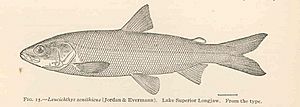Shortjaw cisco facts for kids
Quick facts for kids Shortjaw cisco |
|
|---|---|
 |
|
| Conservation status | |
| Scientific classification |
The shortjaw cisco (Coregonus zenithicus) is a type of freshwater whitefish. It belongs to the salmon family. These fish live in North America.
Adult shortjaw cisco can grow to about 30 cm (12 inches) long. They are silver with a greenish back and a lighter belly. This fish is part of a group called the Coregonus artedi complex of ciscoes.
You can find them in many deep lakes across Canada. However, their numbers have been going down in the Great Lakes. They are no longer found in Michigan, Huron, and Erie.
Shortjaw cisco mainly eat small crustaceans and insect larvae. They lay their eggs in autumn on the lake bed. This fish was once an important part of the cisco (chub) fishing industry in the Great Lakes. The International Union for the Conservation of Nature says the shortjaw cisco is a "vulnerable" species. This means it is at risk of disappearing.
Scientists have found that shortjaw cisco have developed separately in different lakes. This happened from the cisco Coregonus artedi. So, how we protect them might need to be different for each lake.
Contents
What Does a Shortjaw Cisco Look Like?
The shortjaw cisco has large, smooth scales. Its body is shiny silver. It has a greenish back and a white belly. Its mouth is small and has no teeth. The lower jaw is usually shorter than or the same length as the upper jaw.
These fish typically weigh about 300 grams (11 ounces). They are usually between 150 and 300 mm (6 to 12 inches) long. It can be very hard to tell them apart from other cisco species just by looking. But the shortjaw cisco usually has fewer gillrakers than other ciscoes. Gillrakers are small, comb-like structures inside their gills.
Where Do Shortjaw Cisco Live?
The shortjaw cisco used to be common in the upper Great Lakes. But now, they are gone from Lake Michigan. Their numbers are much lower in Lake Huron than they used to be. In Lake Superior, there are fewer shortjaw cisco than in the past. This is based on records from fishing boats. We are not sure about their numbers in Lake Nipigon.
They have also been found in at least 22 other lakes outside the Great Lakes. These lakes are in the Canadian provinces of Ontario, Manitoba, Saskatchewan, Alberta, and the Northwest Territories. We do not know if the remaining Great Lakes populations are growing, shrinking, or staying the same. We also do not know about their numbers in other lakes.
Shortjaw Cisco Homes
Shortjaw cisco are most often found in the deep parts of large lakes. They have been found at depths of 55 to 114 meters (180 to 374 feet) in Lakes Superior, Michigan, and Huron. In Lake Superior, they are known to move to different depths depending on the season.
Life Cycle and Reproduction
Shortjaw cisco lay their eggs in the autumn. The eggs are placed on the lake bottom in deep water. They take about three to four months to hatch. This depends on how warm the water is. These fish become old enough to have babies when they are five years old.
What Do Shortjaw Cisco Eat?
Small crustaceans and insect larvae are very important foods for the shortjaw cisco. Larger fish like Lake trout (Salvelinus namaycush) and burbot (Lota lota) are known to eat shortjaw cisco.
The shortjaw cisco is also thought to be at risk from the sea lamprey (Petromyzon marinus). Sea lampreys are an invasive species. They have likely played a part in the decline of shortjaw cisco in the Great Lakes. As sea lamprey numbers grew, shortjaw cisco numbers went down.
Fishing and Threats
This fish was a big part of the cisco (chub) fishing industry in the Great Lakes. Two other fish, the rainbow smelt (Osmerus mordax) and alewife (Alosa pseudoharengus), were brought into these lakes. They compete with the shortjaw cisco for food and also eat them. This has hurt the shortjaw cisco populations.
All these things together – sea lamprey, competition from other fish, and changes to their habitat from cities, farms, and factories in the Great Lakes Basin – made the shortjaw cisco easy to catch too much. Even fishing at rates that used to be safe became a problem.
In Lake Superior, the shortjaw cisco has been part of deepwater cisco fisheries. Other deepwater ciscoes there include Coregonus hoyi and Coregonus kiyi.
How Scientists Study Shortjaw Cisco
Understanding the group of fish called "ciscoes" can be tricky for scientists. The shortjaw cisco is part of the Coregonus artedi group. This group also includes C. hoyi and C. kiyi.
It was once thought that the shortjaw cisco was the same species as the longjaw cisco (Coregonus alpenae), which is now believed to be extinct. But genetic studies show that the shortjaw cisco is not just one unique type of fish. Instead, it has developed from the Coregonus artedi in different lakes. This means that shortjaw cisco in one lake might be more similar to the C. artedi in that same lake than to shortjaw cisco in another lake.
- Froese, Rainer, and Daniel Pauly, eds. (2006). "Coregonus zenithicus" in FishBase. January 2006 version.
- Hoff MH, Todd TN (2004) Status of the shortjaw cisco (Coregonus zenithicus) in Lake Superior Annales Zoologici Fennici 41:147-154.
Images for kids
See also
 In Spanish: Coregonus zenithicus para niños
In Spanish: Coregonus zenithicus para niños


